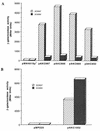rsmC of the soft-rotting bacterium Erwinia carotovora subsp. carotovora negatively controls extracellular enzyme and harpin(Ecc) production and virulence by modulating levels of regulatory RNA (rsmB) and RNA-binding protein (RsmA)
- PMID: 10498717
- PMCID: PMC103632
- DOI: 10.1128/JB.181.19.6042-6052.1999
rsmC of the soft-rotting bacterium Erwinia carotovora subsp. carotovora negatively controls extracellular enzyme and harpin(Ecc) production and virulence by modulating levels of regulatory RNA (rsmB) and RNA-binding protein (RsmA)
Abstract
Previous studies have shown that the production of extracellular enzymes (pectate lyase [Pel], polygalacturonase [Peh], cellulase [Cel], and protease [Prt]) and harpin(Ecc) (the elicitor of hypersensitive reaction) in Erwinia carotovora subsp. carotovora is regulated by RsmA, an RNA-binding protein, and rsmB, a regulatory RNA (Rsm stands for regulator of secondary metabolites) (Y. Liu et al., Mol. Microbiol. 29:219-234, 1998). We have cloned and characterized a novel regulatory gene, rsmC, that activates RsmA production and represses extracellular enzyme and harpin(Ecc) production, rsmB transcription, and virulence in E. carotovora subsp. carotovora. In an rsmC knockout mutant of E. carotovora subsp. carotovora Ecc71 carrying the chromosomal copy of the wild-type rsmA(+) allele, the basal levels of Pel, Peh, Cel, Prt, and harpin(Ecc) as well as the amounts of rsmB, pel-1, peh-1, celV, and hrpN(Ecc) transcripts are high, whereas the levels of rsmA transcripts and RsmA protein are low. Furthermore, the expression of an rsmA-lacZ gene fusion is lower in the RsmC(-) mutant than in the RsmC(+) parent. Conversely, the expression of an rsmB-lacZ operon fusion is higher in the RsmC(-) mutant than in the RsmC(+) parent. These observations establish that RsmC negatively regulates rsmB transcription but positively affects RsmA production. Indeed, comparative studies with an RsmC(-) mutant, an RsmA(-) mutant, and an RsmA(-) RsmC(-) double mutant have revealed that the negative effects on exoprotein production and virulence are due to the cumulative regulatory effects of RsmC on rsmA and rsmB. Exoprotein production by the RsmC(-) mutant is partially dependent on the quorum sensing signal, N-(3-oxohexanoyl)-L-homoserine lactone. Southern blot data and analysis of PCR products disclosed the presence of rsmC sequences in E. carotovora subsp. atroseptica, E. carotovora subsp. betavasculorum, and E. carotovora subsp. carotovora. These findings collectively support the idea that rsmA and rsmB expression in these plant pathogenic Erwinia species is controlled by RsmC or a functional homolog of RsmC.
Figures







Similar articles
-
Regulatory network controlling extracellular proteins in Erwinia carotovora subsp. carotovora: FlhDC, the master regulator of flagellar genes, activates rsmB regulatory RNA production by affecting gacA and hexA (lrhA) expression.J Bacteriol. 2008 Jul;190(13):4610-23. doi: 10.1128/JB.01828-07. Epub 2008 Apr 25. J Bacteriol. 2008. PMID: 18441056 Free PMC article.
-
hexA of Erwinia carotovora ssp. carotovora strain Ecc71 negatively regulates production of RpoS and rsmB RNA, a global regulator of extracellular proteins, plant virulence and the quorum-sensing signal, N-(3-oxohexanoyl)-L-homoserine lactone.Environ Microbiol. 2000 Apr;2(2):203-15. doi: 10.1046/j.1462-2920.2000.00093.x. Environ Microbiol. 2000. PMID: 11220306
-
Effects of the two-component system comprising GacA and GacS of Erwinia carotovora subsp. carotovora on the production of global regulatory rsmB RNA, extracellular enzymes, and harpinEcc.Mol Plant Microbe Interact. 2001 Apr;14(4):516-26. doi: 10.1094/MPMI.2001.14.4.516. Mol Plant Microbe Interact. 2001. PMID: 11310739
-
Identification of a global repressor gene, rsmA, of Erwinia carotovora subsp. carotovora that controls extracellular enzymes, N-(3-oxohexanoyl)-L-homoserine lactone, and pathogenicity in soft-rotting Erwinia spp.J Bacteriol. 1995 Sep;177(17):5108-15. doi: 10.1128/jb.177.17.5108-5115.1995. J Bacteriol. 1995. PMID: 7665490 Free PMC article.
-
Global regulation by the small RNA-binding protein CsrA and the non-coding RNA molecule CsrB.Mol Microbiol. 1998 Sep;29(6):1321-30. doi: 10.1046/j.1365-2958.1998.01021.x. Mol Microbiol. 1998. PMID: 9781871 Review.
Cited by
-
Biofilm formation and dispersal under the influence of the global regulator CsrA of Escherichia coli.J Bacteriol. 2002 Jan;184(1):290-301. doi: 10.1128/JB.184.1.290-301.2002. J Bacteriol. 2002. PMID: 11741870 Free PMC article.
-
Regulatory network controlling extracellular proteins in Erwinia carotovora subsp. carotovora: FlhDC, the master regulator of flagellar genes, activates rsmB regulatory RNA production by affecting gacA and hexA (lrhA) expression.J Bacteriol. 2008 Jul;190(13):4610-23. doi: 10.1128/JB.01828-07. Epub 2008 Apr 25. J Bacteriol. 2008. PMID: 18441056 Free PMC article.
-
Molecular characterization of global regulatory RNA species that control pathogenicity factors in Erwinia amylovora and Erwinia herbicola pv. gypsophilae.J Bacteriol. 2001 Mar;183(6):1870-80. doi: 10.1128/JB.183.6.1870-1880.2001. J Bacteriol. 2001. PMID: 11222584 Free PMC article.
-
Solution structure of the carbon storage regulator protein CsrA from Escherichia coli.J Bacteriol. 2005 May;187(10):3496-501. doi: 10.1128/JB.187.10.3496-3501.2005. J Bacteriol. 2005. PMID: 15866937 Free PMC article.
-
SlyA regulates type III secretion system (T3SS) genes in parallel with the T3SS master regulator HrpL in Dickeya dadantii 3937.Appl Environ Microbiol. 2012 Apr;78(8):2888-95. doi: 10.1128/AEM.07021-11. Epub 2012 Jan 20. Appl Environ Microbiol. 2012. PMID: 22267675 Free PMC article.
References
-
- Aiba H, Adhya S, de Crombrugghe B. Evidence for two functional gal promoters in intact Escherichia coli cells. J Biol Chem. 1981;256:11905–11910. - PubMed
-
- Barras F, van Gijsegem F, Chatterjee A K. Extracellular enzymes and pathogenesis of soft-rot Erwinia. Annu Rev Phytopathol. 1994;32:201–234.
-
- Bauer D W, Wei Z-M, Beer S V, Collmer A. Erwinia chrysanthemi harpinEch: an elicitor of the hypersensitive response that contributes to soft-rot pathogenesis. Mol Plant-Microbe Interact. 1995;8:484–491. - PubMed
-
- Chatterjee A, Cui Y, Liu Y, Dumenyo C K, Chatterjee A K. Inactivation of rsmA leads to overproduction of extracellular pectinases, cellulases, and proteases in Erwinia carotovora subsp. carotovora in the absence of the starvation/cell density-sensing signal, N-(3-oxohexanoyl)-l-homoserine lactone. Appl Environ Microbiol. 1995;61:1959–1967. - PMC - PubMed
-
- Chatterjee A K, Vidaver A K. Genetics of pathogenicity factors: application to phytopathogenic bacteria. In: Ingram D S, Williams P H, editors. Advances in plant pathology. Vol. 4. London, England: Academic Press; 1986. pp. 1–224.
Publication types
MeSH terms
Substances
Associated data
- Actions
LinkOut - more resources
Full Text Sources
Other Literature Sources
Molecular Biology Databases

